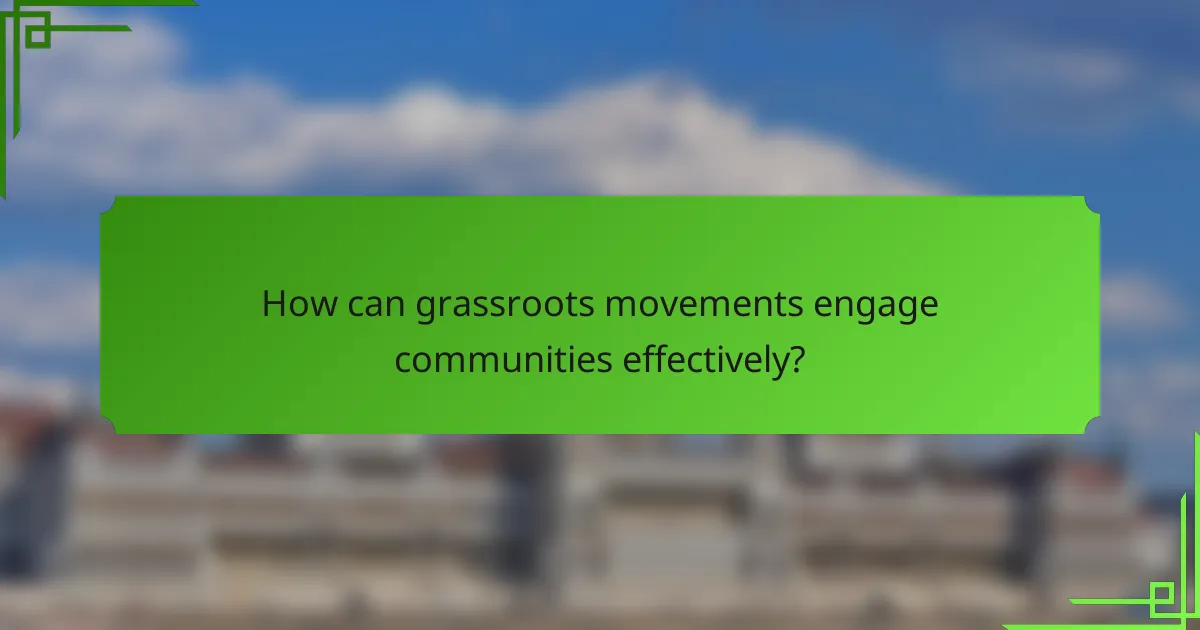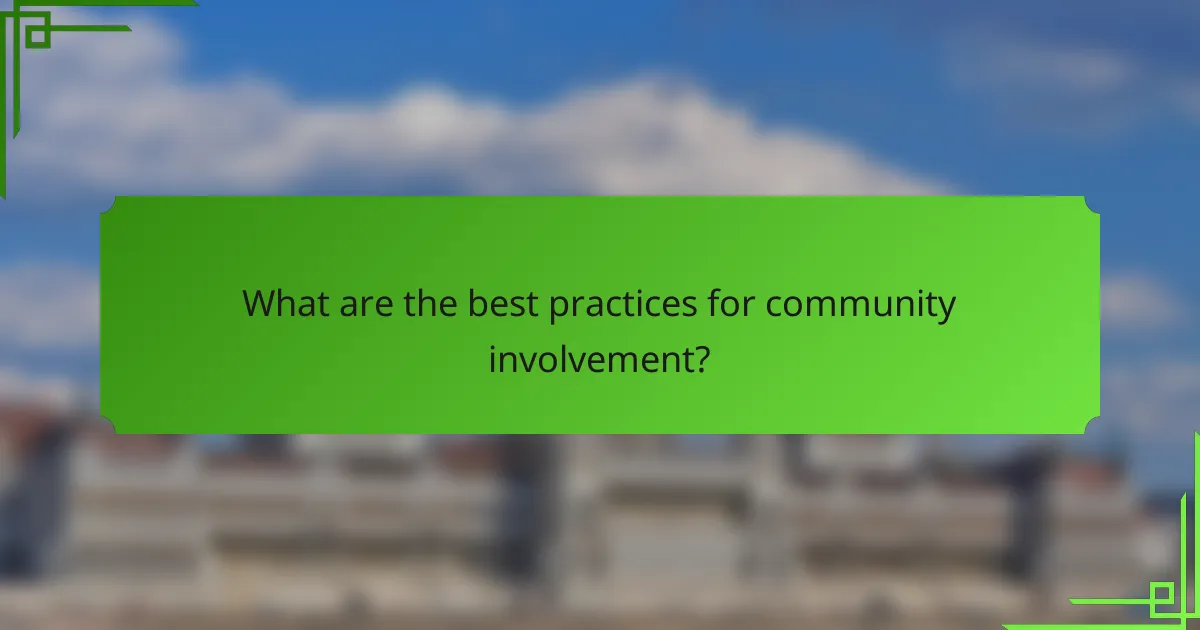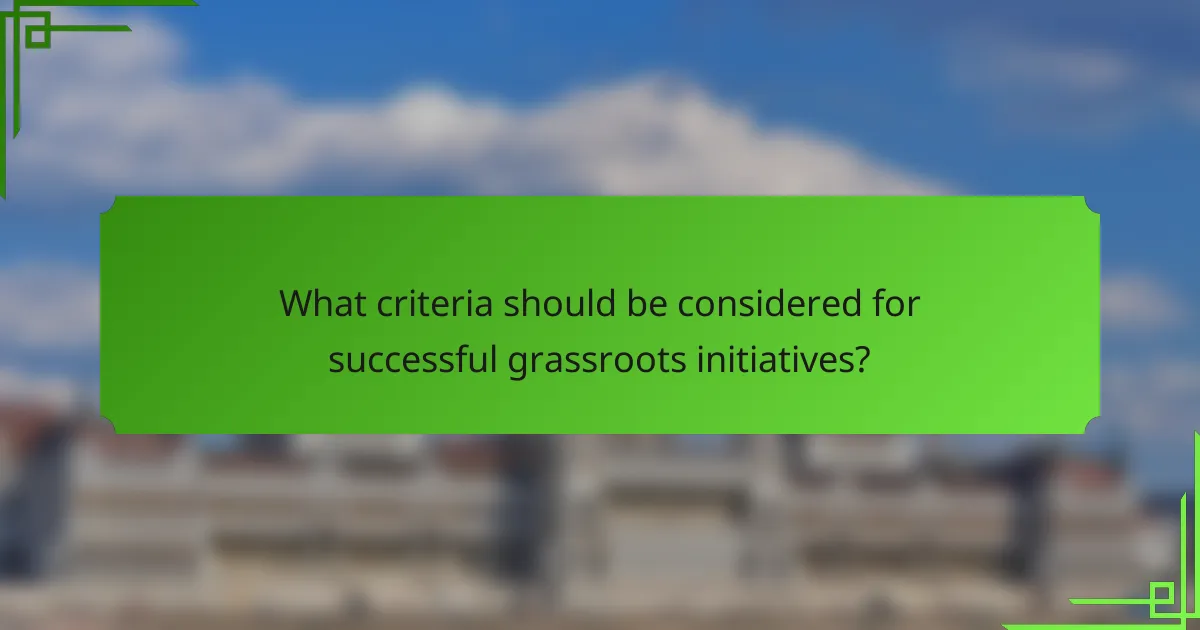Grassroots movements play a crucial role in mobilizing communities by encouraging active participation and fostering meaningful relationships among residents. By implementing targeted engagement strategies, these movements can effectively interact with elected officials and amplify community voices in the political arena. Ensuring that community involvement is inclusive and values feedback is essential for creating an empowered environment where individuals feel motivated to contribute to advocacy efforts.

How can grassroots movements engage communities effectively?
Grassroots movements can engage communities effectively by fostering participation and building relationships. This involves utilizing various strategies that resonate with local residents and encourage their involvement in advocacy efforts.
Utilizing social media platforms
Social media platforms are powerful tools for grassroots movements to connect with communities. By creating engaging content and using targeted ads, movements can reach a wider audience and mobilize support quickly.
Consider platforms like Facebook, Twitter, and Instagram, which allow for direct interaction and feedback. Regular updates, live events, and community polls can enhance engagement and keep the conversation going.
Organizing local events
Local events are essential for grassroots movements to build community ties and foster participation. Organizing town halls, workshops, or community clean-up days can bring people together and create a sense of shared purpose.
When planning events, ensure they are accessible and inclusive. Consider factors such as location, timing, and potential barriers to participation, such as transportation or language. Engaging local leaders as speakers can also boost attendance and credibility.
Creating community newsletters
Community newsletters serve as an effective way to keep residents informed and engaged. Regularly distributing newsletters—whether digitally or in print—can share updates on initiatives, upcoming events, and local issues that matter to residents.
Focus on clear, concise writing and visually appealing layouts. Including sections for community voices or local success stories can foster a sense of ownership and encourage more residents to participate in grassroots efforts.
Building partnerships with local organizations
Forming partnerships with local organizations can amplify the impact of grassroots movements. Collaborating with schools, nonprofits, or businesses can provide additional resources, expertise, and credibility.
Identify organizations that share similar goals and values. Joint initiatives, such as co-hosting events or sharing resources, can enhance outreach and strengthen community ties, ultimately leading to greater engagement and support for the movement.

What strategies enhance interaction with elected officials?
Effective strategies for enhancing interaction with elected officials include organizing community events, leveraging advocacy campaigns, and engaging in direct lobbying efforts. These approaches foster communication, build relationships, and amplify community voices in the political process.
Scheduling town hall meetings
Town hall meetings provide a platform for constituents to engage directly with elected officials. By organizing these events, communities can facilitate open dialogue, allowing officials to hear concerns and feedback firsthand.
To maximize attendance, consider scheduling meetings during evenings or weekends when more people are available. Promote the event through social media, local news outlets, and community boards to ensure broad participation.
Utilizing advocacy campaigns
Advocacy campaigns mobilize community members around specific issues, creating a unified voice that can influence elected officials. These campaigns often utilize petitions, social media outreach, and public demonstrations to raise awareness and garner support.
When launching an advocacy campaign, clearly define the goals and the desired outcomes. Utilize compelling narratives and data to engage supporters and encourage them to share the campaign with their networks.
Engaging in direct lobbying efforts
Direct lobbying involves meeting with elected officials or their staff to discuss specific legislation or policy issues. This strategy allows grassroots movements to present their case directly and advocate for change.
Prepare for lobbying meetings by researching the official’s stance on relevant issues and tailoring your message accordingly. Bring along supporting materials, such as fact sheets or personal stories, to strengthen your argument and make a lasting impression.

What are the best practices for community involvement?
Effective community involvement hinges on fostering active participation, ensuring feedback is valued, and promoting inclusive discussions. These best practices create a vibrant environment where community members feel empowered to contribute and engage meaningfully.
Encouraging volunteer participation
To boost volunteer participation, organizations should clearly communicate the impact of volunteer efforts. Highlighting specific roles, responsibilities, and the benefits of volunteering can attract more individuals. For example, hosting informational sessions can help potential volunteers understand how they can contribute to community goals.
Offering flexible volunteering options, such as remote or short-term opportunities, can also increase engagement. Consider creating a volunteer recognition program to celebrate contributions, which can further motivate individuals to participate actively.
Implementing feedback mechanisms
Establishing effective feedback mechanisms is crucial for community involvement. Regular surveys, suggestion boxes, and community forums allow members to voice their opinions and ideas. These tools should be easily accessible and encourage honest feedback to foster a culture of openness.
It’s essential to act on the feedback received. Communicating changes made based on community input shows that their voices matter, which can enhance trust and encourage ongoing participation. Consider setting up regular updates to inform the community about how their feedback is being utilized.
Fostering inclusive discussions
Inclusive discussions ensure that all community voices are heard and valued. Creating a safe space for dialogue can help individuals from diverse backgrounds feel comfortable sharing their perspectives. This can be achieved through moderated forums, workshops, or town hall meetings that encourage participation from everyone.
Utilizing various communication channels, such as social media, newsletters, and local events, can help reach a broader audience. Additionally, providing materials in multiple languages or formats can further enhance inclusivity, ensuring that all community members can engage in meaningful discussions.

What criteria should be considered for successful grassroots initiatives?
Successful grassroots initiatives should focus on community engagement, clear objectives, and sustainable resource management. These criteria ensure that the movement resonates with local needs and can maintain momentum over time.
Identifying community needs
Understanding community needs is the foundation of any grassroots initiative. Conduct surveys, hold focus groups, or organize community meetings to gather input directly from residents. This engagement helps identify pressing issues, such as access to healthcare, education, or public safety.
Utilizing tools like community asset mapping can also clarify strengths and weaknesses within the community. By visually representing resources and gaps, organizers can prioritize initiatives that address the most critical needs effectively.
Assessing resource availability
Evaluating available resources is essential for planning and executing grassroots initiatives. This includes financial resources, volunteer support, and local partnerships. Consider creating a resource inventory that lists potential funding sources, local businesses willing to collaborate, and community members who can contribute time or skills.
Be realistic about what can be achieved with the resources at hand. It’s often beneficial to start small with pilot projects that require minimal funding and can demonstrate impact, making it easier to secure additional support later on.

How can grassroots movements measure their impact?
Grassroots movements can measure their impact through various methods that assess engagement, feedback, and overall effectiveness. By employing metrics and gathering community insights, these movements can understand their reach and influence more clearly.
Tracking engagement metrics
Tracking engagement metrics involves monitoring participation levels, social media interactions, and event attendance. Key indicators may include the number of volunteers, online shares, and comments on posts, which can provide insights into community interest and involvement.
Consider using tools like Google Analytics for website traffic or social media analytics platforms to gauge online engagement. Aim for a consistent review of these metrics, ideally on a monthly basis, to identify trends and adjust strategies accordingly.
Conducting surveys and feedback
Conducting surveys and gathering feedback from community members is essential for understanding the effectiveness of grassroots initiatives. Surveys can be distributed online or during events, focusing on participants’ experiences, suggestions, and overall satisfaction.
Utilize simple tools like Google Forms or SurveyMonkey to create and analyze surveys. Aim for a response rate of at least 20-30% to ensure the feedback is representative. Regularly review the feedback to make informed decisions about future actions and to enhance community engagement.

What emerging trends are shaping grassroots movements?
Grassroots movements are increasingly influenced by digital innovation, social justice issues, and community engagement strategies. These trends facilitate greater participation and connection among activists, enabling them to mobilize effectively and advocate for change.
Increased use of digital tools
The rise of digital tools has transformed grassroots movements by enhancing communication and outreach. Social media platforms, mobile apps, and online petitions allow organizers to reach wider audiences quickly and efficiently.
For example, platforms like Change.org enable users to create and share petitions that can gather thousands of signatures in a matter of days. Additionally, tools like Slack or Discord facilitate real-time collaboration among team members, making coordination smoother.
However, reliance on digital tools can also lead to challenges, such as information overload or the risk of misinformation. It’s essential for organizers to verify sources and maintain clear messaging to avoid confusion among supporters.
